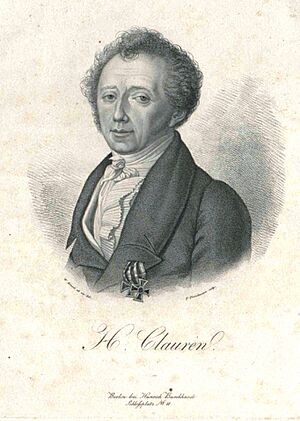Heinrich Clauren facts for kids
Quick facts for kids
Heinrich Clauren
|
|
|---|---|

Lithograph
|
|
| Born | Carl Gottlieb Samuel Heun 20 March 1771 Doberlug-Kirchhain, Lusatia |
| Died | 2 August 1854 (aged 83) Berlin |
| Pen name | Heinrich Clauren |
| Occupation | Author |
| Language | German |
Carl Gottlieb Samuel Heun (born March 20, 1771 – died August 2, 1854) was a German writer. He is much better known by his pen name, Heinrich Clauren. A pen name is a fake name a writer uses instead of their real name. Heun became very popular for his stories in the early 1800s.
Contents
Who Was Heinrich Clauren?
Carl Gottlieb Samuel Heun was born on March 20, 1771, in Doberlug, a town in Germany. He worked for the government in Prussia. But in his free time, he loved to write stories. He used the pen name H. Clauren. This name was actually an anagram of his real name, Carl Heun. An anagram is when you rearrange the letters of a word or name to make a new one.
Clauren quickly became one of the most popular writers of his time. His stories were especially loved by the middle class in the early 1800s.
A Famous Writer's Prank
In 1825, another German writer named Wilhelm Hauff wrote a funny story. It was a parody of Heun's novels. A parody is a humorous imitation of someone else's work. Hauff's story was called Der Mann im Monde (The Man in the Moon). He even published it using Heun's pen name, H. Clauren.
Heun was not happy about this. He took Hauff to court and won the case. Because of this, Hauff wrote another book in 1826. It was called Kontroverspredigt über H. Clauren und den Mann im Mond. This book made fun of Heun's writing even more. It ended up hurting Heun's good reputation as a writer.
Heun's collected stories were published in 25 books in 1851. They were called Gesammelte Schriften. He passed away on August 2, 1854, in Berlin.
How Clauren Influenced Other Writers
Heinrich Clauren's stories had a big impact on other famous writers. Some of his short stories were translated into other languages.
Inspiring Frankenstein
One of Heun's short stories was called "Die graue Stube" (The Grey Room). It was translated into French for a collection of ghost stories called Fantasmagoriana in 1812.
In 1816, a group of famous writers read this book. They were Lord Byron, Mary Shelley, Percy Bysshe Shelley, John William Polidori, and Claire Clairmont. They were staying at a house called Villa Diodati in Switzerland. It was a very rainy summer, so they stayed inside and read ghost stories.
Reading Fantasmagoriana inspired them to write their own scary tales. This led to two very famous books: "The Vampyre" (1819) and Frankenstein (1818). Both of these books helped create the Gothic horror style of writing. Experts say that many ideas in Frankenstein came from the stories in Fantasmagoriana, including Heun's "Die graue Stube".
Influence on Edgar Allan Poe
Another one of Heun's short stories was "Das Raubschloß" (The Robber's Castle). This story might have inspired Edgar Allan Poe's famous story, "The Fall of the House of Usher" (1839). Heun's story was translated into English as "The Robber's Tower" and published in a magazine.
Mentioned in Buddenbrooks
Even later, in 1901, the famous German writer Thomas Mann mentioned Clauren. In Mann's novel Buddenbrooks, a young character named Miss Antonie Buddenbrook is shown reading Clauren's novel Mimili.
English Translations of Clauren's Works
Many of Heinrich Clauren's stories were translated into English over the years. This allowed more people to read his popular works.
Here are a few examples of his stories that were translated:
- "Nordische Liebe" (Northern Love)
- "Die Launen der Liebe" (The Humours of Love)
- "Der Wehrmann" (The Apparition)
- "Der Grünmantel von Venedig" (The Green Mantle of Venice: A True Story)
- "Liesli oder der Kirchhof zu Schwyz" (The Church-Yard of Schwytz)
- "Mimili"
- "Das Raubschloß" (The Robber's Tower or The Robber's Castle)
- "Die Großmutter" (My Grandmother)
- "Die graue Stube" (The Grey Chamber or The Gray Room: A True Story)
- "Lied der Preussen" (Song of the Prussians)
See also
- Christian Köhler, an artist who worked for Heun

